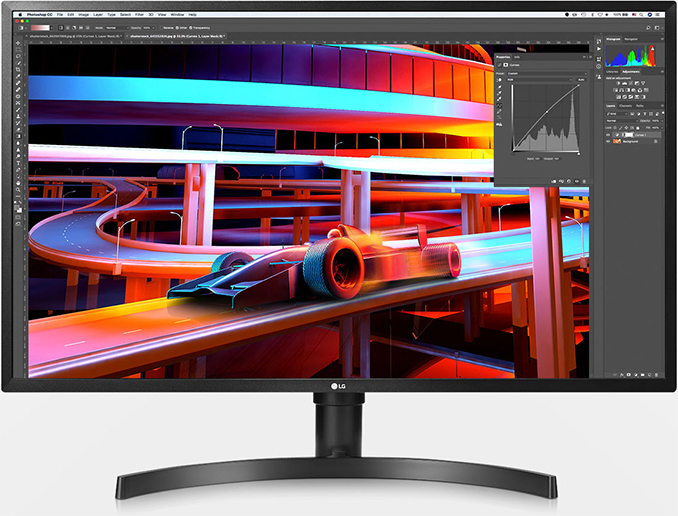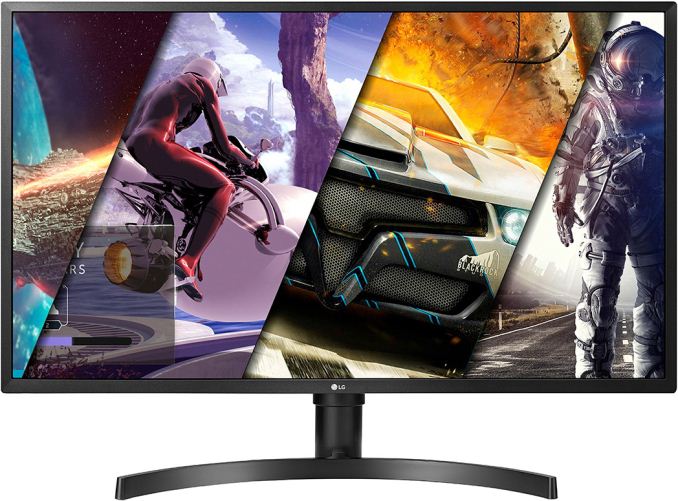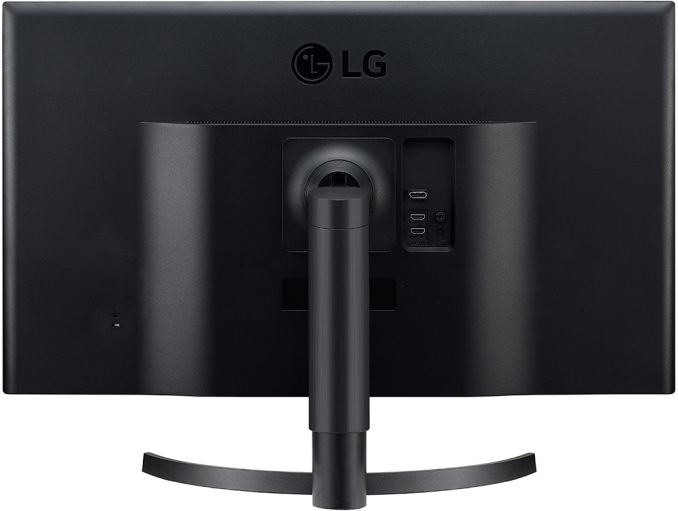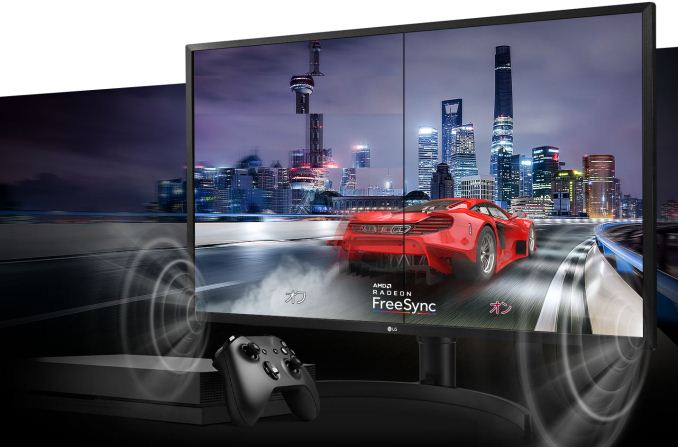LG Unveils 32UK550: 31.5 Inch 4K Display with DCI-P3, HDR10, & FreeSync for $500
by Anton Shilov on September 28, 2018 12:00 PM EST
LG has introduced a new 31.5-inch monitor aimed at the midrange market. Dubbed the 32UK550-B, it's an Ultra-HD display that supports HDR10, covers 95% of the DCI-P3 color space, and features AMD’s FreeSync dynamic refresh rate tech. The unit appears to be LG’s first HDR-capable large-screen LCD in a sub-$500 price band. For its initial announcement LG focused on Japan, but I have no doubt we'll eventually see for sale in other countries as well.
The 32UK550-B is based on a VA panel with a native 3840×2160 resolution. The panel can reproduce 1.07 billion colors over 95% of the DCI-P3 color space, or alternatively it can hit 100% of the sRGB color gamut. As an added bonus, the monitor comes factory-calibrated. The panel features a 300 nits typical brightness, a 3000:1 contrast ratio, a 4 ms GtG response time, a 60 Hz refresh rate, and your VA-standard 178°/178° horizontal/vertical viewing angles.
The monitor also supports HDR10, AMD’s FreeSync dynamic refresh rate technology with a 40 – 60 Hz range, and LG’s Super Resolution+ upscaling tech. It's also worth noting that the display features LF’s Black Stabilizer (increases brightness of dark scenes in games) and Dynamic Action Sync (bypasses internal processing to reduce input lag) modes for gaming, so it looks like LG is also aiming the monitor at casual gamers.
When it comes to input/output capabilities, the 32UK550-B is equipped with two HDMI 2.0a ports, as well as one DisplayPort 1.2 input. All of the display inputs support HDCP 2.2, which of course is required by most major services to watch Ultra-HD and/or HDR10 content. Meanwhile the monitor has two 5 W speakers and a headphone output for audio, however you won't find any USB ports.
| Specifications of the LG 32UK550-B Display | |
| 32UK550-B | |
| Panel | 31.5" VA |
| Native Resolution | 3840 × 2160 |
| Maximum Refresh Rate | 60 Hz |
| Response Time | 4 ms |
| Brightness | 300 cd/m² (typical) |
| Contrast | 3000:1 |
| Viewing Angles | 178°/178° horizontal/vertical |
| HDR | HDR10 |
| Dynamic Refresh Rate | AMD FreeSync (at 40 ~ 60 Hz) |
| Pixel Pitch | 0.1816 mm² |
| Pixel Density | 140 ppi |
| Display Colors | 1.07 billion |
| Color Gamut Support | DCI-P3: 95% sRGB: 100% |
| Stand | Tilt (5~15°), height (110 mm) adjustable |
| Inputs | 1 × DisplayPort 1.2 2 × HDMI 2.0a HDCP 2.2 |
| USB Hub | - |
| Audio | 5 W × 2 audio out port |
| Launch Price | ~$500 (not confirmed by LG) |
Looking at LG's broader lineup, the company has offered sub-$500 31.5-inch 4K displays in its lineup for a while now. For example, the company has been selling its 32UD60-B monitor for around $500 since early 2018. Unlike the flagship 32UD99-W and 32UK950-W, LG’s inexpensive 31.5-inch Ultra-HD LCDs do not use IPS panels, but rely on the VA technology. In the meantime, the 32UK550-B is LG’s first reasonably priced large 4K monitor to support the HDR10 transport format. With that said, while the monitor can take an HDR signal, its 300 nits brightness is barely enough for a quality HDR experience. But at least the tech is supported on paper, right?
LG Japan will start sales of the 32UK550-B display on October 11 with an MSRP of ¥55,000 w/o tax ($485). Considering the fact that PC hardware is usually a bit more expensive in Japan, I'd expect the monitor to cost around $500 in other countries. In the meantime, LG offers its sans-HDR VA-based 32UD60-B for around $530 in the U.S.
Related Reading:
- LG Develops ‘Nano IPS’ LCD, Unveils 32UK950 4K Display with DCI-P3, HDR600, TB3
- LG Announces the 5K UltraWide 34WK95U: A 'Nano IPS' Monitor with a HDR600 Badge
- LG Unveils UltraGear 34GK950 34-Inch Curved Gaming Displays with Nano-IPS
- LG Announces 32UD99: 4K IPS Display with 95% DCI-P3, HDR and USB-C













28 Comments
View All Comments
Diji1 - Tuesday, October 2, 2018 - link
G-sync is limited to high quality panels, so yes, there's many other lower quality options withAdaptive Sync.
mode_13h - Friday, September 28, 2018 - link
For a HDR monitor, you'd really want FreeSync 2.https://www.anandtech.com/show/10967/amd-announces...
MartiCode - Friday, September 28, 2018 - link
Still waiting for the LG 34WK95U, announced in January, to ship. They should not announce what they can't apparently sell until a year later.DanNeely - Monday, October 1, 2018 - link
believe it or not, monitor companies develop a number of panels in parallel. One having encountered some major problem that's severely delayed it from reaching production ready status, doesn't impact the progress of their other product teams.timecop1818 - Saturday, September 29, 2018 - link
HDR with 300nits brightness panel? isn't that kinda garbage?still waiting for something in 23-24" class with 4K, 10 bit color, 400+ nits GB-R backlight (or proven wide gamut with wled), that isn't Dell UP2414Q because that shit has severe DisplayPort stability issues.
andy o - Saturday, September 29, 2018 - link
I've got the more expensive 27UK850 and HDR in these monitors is indeed garbage. I didn't buy it for that though so I was cool with it and knew before buying. In "HDR" mode the monitor just pretty much disables your control of backlight and pumps it up extremely high so that there is nothing that can be considered "black" anymore in the picture. I use it in a dark room so it's extra terrible for me.I don't think any LCD without local dimming is going to be very good at HDR anyway. And local dimming has its own problems. I'd rather have a monitor that doesn't have as high max brightness, but has deeper blacks, and unfortunately the only option right now is very expensive OLED for TVs, and for monitors there aren't really any options.
andy o - Saturday, September 29, 2018 - link
Basically, I don't see much of a difference betwen this "HDR" thing for new monitors and the old "dynamic contrast" numbers scam of yesteryear.a5cent - Saturday, September 29, 2018 - link
HDR at 300 nits? I wouldn't say garbage. It can still be a very usable monitor. Just not for HDR. In a sane world it would be classified as false advertising. Even the DisplayHDR 400 certification (400 nits) is marketing BS. These HDR monitors won't necessarily provide better images than a good SDR monitor.Of course, a DisplayHDR 400 monitor will almost always be better than the average bargain bin SDR monitor. I suspect that's how average Joe will eventually conclude HDR is better. Not because they are actually getting a decent HDR experience, but because DisplayHDR certification prevents usage of the most atrocious cost cutting measures.
It's only at DisplayHDR 1000 (and only with rare HDR content) where benefits become obvious.
a5cent - Saturday, September 29, 2018 - link
Almost forget... just with a HDR badge, but without DisplayHDR certification (like this monitor), all bets are off. Such a monitor can, but doesn't have to be, bargain bin trash, because there is no technical standard that defines what a HDR monitor is or must do (hence the DisplayHDR standard).Soon almost every FreeSync scaler for $2 will accept a HDR10 signal, so every new (non g-sync) monitor, no matter how terrible, could theoretically be called a HDR monitor.
milkywayer - Sunday, September 30, 2018 - link
We have Rtings the reviews for a reason :)Have they started reviewing monitors or still TVs only?